begin quote from:
Weekly U.S. Influenza Surveillance Report

Note: CDC is tracking the COVID-19 pandemic in a weekly publication called COVIDView.
All data are preliminary and may change as more reports are received.
A description of the CDC influenza surveillance system, including methodology and detailed descriptions of each data component is available on the surveillance methods page.
Additional information on the current and previous influenza seasons for each surveillance component are available on FluView Interactive.
U.S. Virologic Surveillance:
Clinical Laboratories
Data from clinical laboratories (the percentage of specimens tested that are positive for influenza) are used to monitor whether influenza activity is increasing or decreasing.
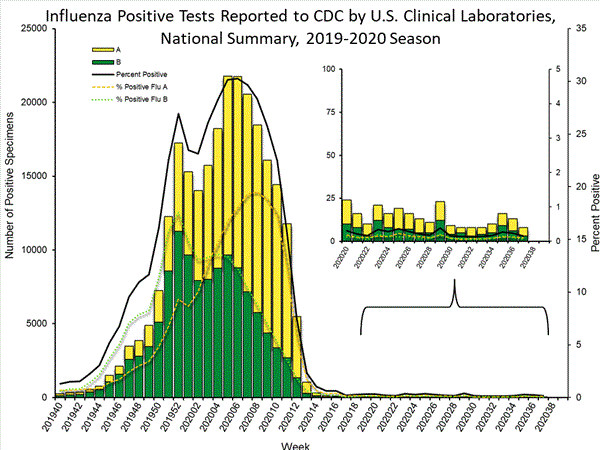
View Chart Data | View Full Screen
Public Health Laboratories
Data from public health laboratories are used to monitor the proportion of circulating viruses that belong to each influenza subtype/lineage.
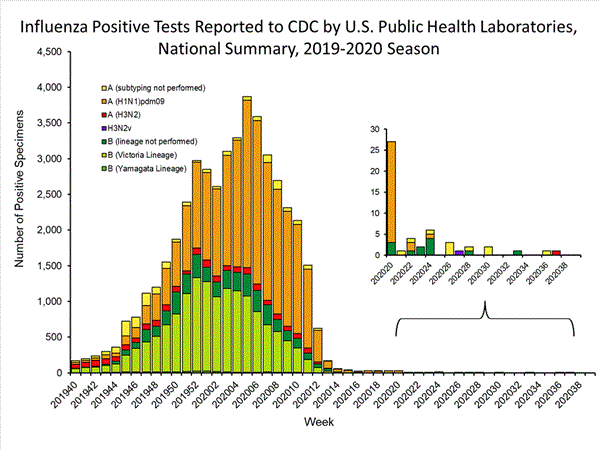
View Chart Data | View Full Screen
Additional virologic surveillance information for current and past seasons:
Surveillance Methods | FluView Interactive: National, Regional, and State Data or Age Data
Outpatient Illness Surveillance
ILINet
Nationwide during week 37, 1.0% of patient visits reported through the U.S. Outpatient Influenza-like Illness Surveillance Network (ILINet) were due to influenza-like illness (ILI). This percentage is below the national baseline of 2.4%.
Note: In response to the COVID-19 pandemic, new data sources will be incorporated into ILINet throughout the summer weeks when lower levels of influenza and other respiratory virus circulation are typical. Starting in week 21, increases in the number of patient visits will be seen as new sites are enrolled and the percentage of visits for ILI may change in comparison to previous weeks. While all regions remain below baseline levels for ILI, these system changes should be kept in mind when drawing conclusions from these data. Any changes in ILI due to changes in respiratory virus circulation will be highlighted here
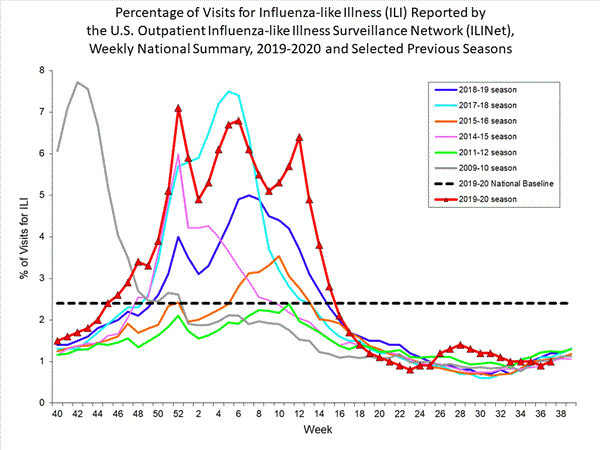
View Chart Data (current season only) | View Full Screen
ILI Activity Map
Data collected in ILINet are used to produce a measure of ILI activity* by state.
During week 37, the following ILI activity levels were experienced:
- High – Iowa
- Moderate – Puerto Rico.
- Minimal –District of Columbia, New York City, and 47 states (Alabama, Arizona, Arkansas, California, Colorado, Connecticut, Delaware, Florida, Georgia, Hawaii, Idaho, Illinois, Indiana, Kansas, Kentucky, Louisiana, Maine, Maryland, Massachusetts, Michigan, Minnesota, Mississippi, Missouri, Montana, Nebraska, Nevada, New Hampshire, New Jersey, New Mexico, New York, North Carolina, North Dakota, Ohio, Oklahoma, Oregon, Pennsylvania, Rhode Island, South Carolina, South Dakota, Tennessee, Texas, Utah, Vermont, Virginia, Washington, West Virginia, and Wisconsin).
- Data were insufficient to calculate an ILI activity level from two states (Alaska and Wyoming) and the U.S. Virgin Islands.
*Data collected in ILINet may disproportionally represent certain populations within a state, and therefore, may not accurately depict the full picture of influenza activity for the whole state. Differences in the data presented here by CDC and independently by some state health departments likely represent differing levels of data completeness with data presented by the state likely being the more complete.
Additional information about medically attended visits for ILI for current and past seasons:
Surveillance Methods | FluView Interactive: National, Regional, and State Data or ILI Activity Map
Influenza-Associated Hospitalizations:
The Influenza Hospitalization Surveillance Network (FluSurv-NET) conducts all age population-based surveillance for laboratory-confirmed influenza-related hospitalizations in select counties in the Emerging Infections Program (EIP) states and Influenza Hospitalization Surveillance Project (IHSP) states.
As in previous seasons, patients admitted for laboratory-confirmed influenza-related hospitalization after April 30, 2020 will not be included in FluSurv-NET. Data on patients admitted through April 30, 2020 will continue to be updated as additional information is received.
Additional hospitalization surveillance information for current and past seasons and additional age groups:
Surveillance Methods | FluView Interactive: Rates by Age or Patient Characteristics
Pneumonia and Influenza (P&I) Mortality Surveillance
Based on National Center for Health Statistics (NCHS) mortality surveillance data available on September 17, 2020, 5.3% of the deaths occurring during the week ending September 12, 2020 (week 37) were due to P&I. This percentage is below the epidemic threshold of 5.5% for week 37.
Weekly mortality surveillance data include a combination of machine coded and manually coded causes of death collected from death certificates. Percentages of deaths due to pneumonia and influenza (P&I) are higher among manually coded records than more rapidly available machine coded records. Due to the additional time needed for manual coding, the initially reported P&I percentages are likely to increase as more data are received and processed.
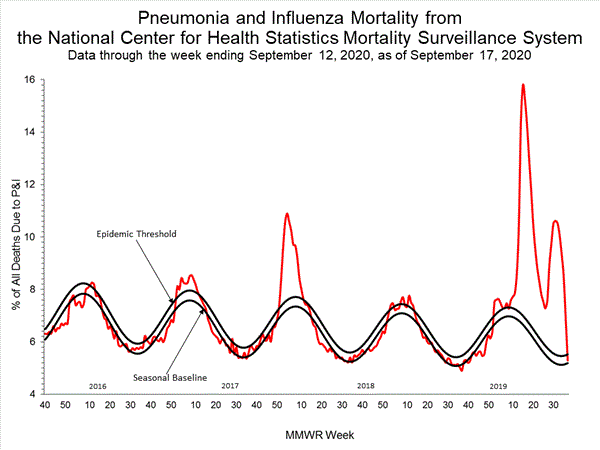
View Chart Data | View Full Screen
Additional pneumonia and influenza mortality surveillance information for current and past seasons:
Surveillance Methods | FluView Interactive
Influenza-Associated Pediatric Mortality
No influenza-associated pediatric deaths occurring during the 2019-2020 season were reported to CDC during week 37.
A total of 188 influenza-associated pediatric deaths occurring during the 2019-2020 season have been reported to CDC.
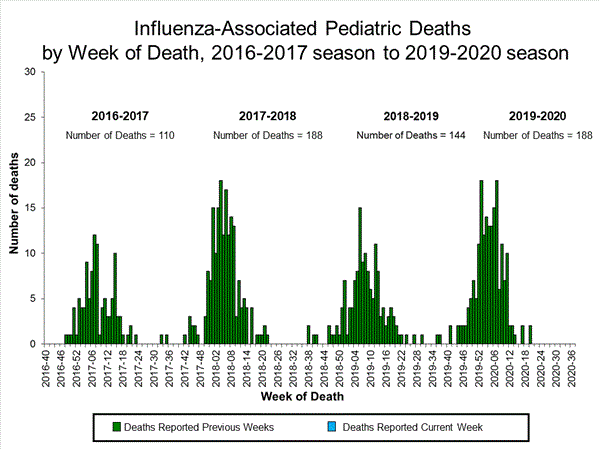
Additional pediatric mortality surveillance information for current and past seasons:
Surveillance Methods | FluView Interactive
Additional National and International Influenza Surveillance Information
FluView Interactive: FluView includes enhanced web-based interactive applications that can provide dynamic visuals of the influenza data collected and analyzed by CDC. These FluView Interactive applications allow people to create customized, visual interpretations of influenza data, as well as make comparisons across flu seasons, regions, age groups and a variety of other demographics.
National Institute for Occupational Safety and Health: Monthly surveillance data on the prevalence of health-related workplace absenteeism among full-time workers in the United States are available from NIOSH.
U.S. State and local influenza surveillance: Select a jurisdiction below to access the latest local influenza information.
World Health Organization:
Additional influenza surveillance information from participating WHO member nations is available through
FluNet and the Global Epidemiology Reports.
WHO Collaborating Centers for Influenza:
Australia, China, Japan, the United Kingdom, and the United States (CDC in Atlanta, Georgia)
Europe:
The most up-to-date influenza information from Europe is available from WHO/Europe and the European Centre for Disease Prevention and Control.
Public Health Agency of Canada:
The most up-to-date influenza information from Canada is available in Canada’s weekly FluWatch report.
Public Health England:
The most up-to-date influenza information from the United Kingdom is available from Public Health England.
Any links provided to non-Federal organizations are provided solely as a service to our users. These links do not constitute an endorsement of these organizations or their programs by CDC or the Federal Government, and none should be inferred. CDC is not responsible for the content of the individual organization web pages found at these links.
A description of the CDC influenza surveillance system, including methodology and detailed descriptions of each data component is available on the surveillance methods page.
No comments:
Post a Comment